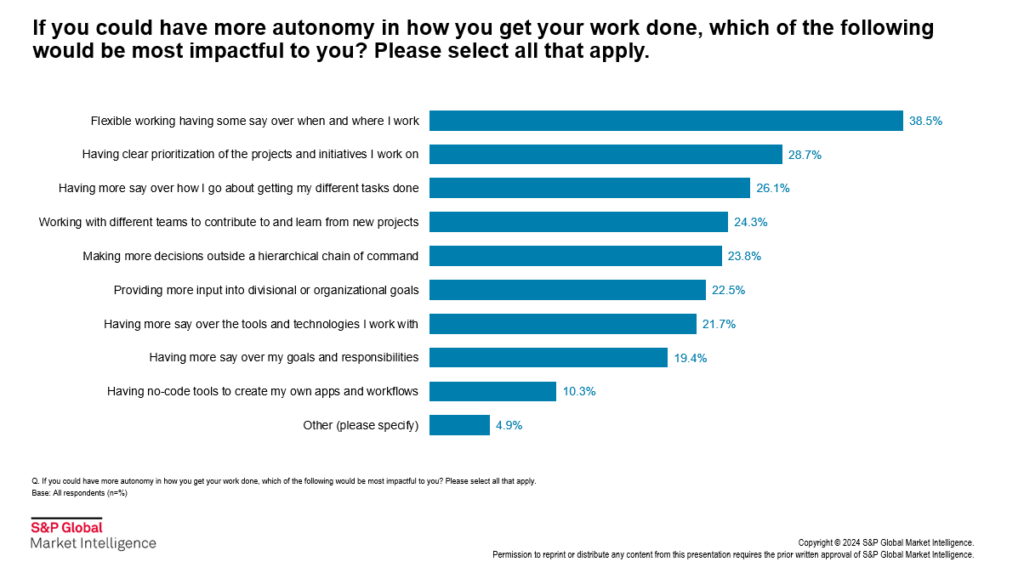
Work is undergoing large-scale, rapid transformation, and to chart an effective path forward, organizations need more than piecemeal change. New thinking around operational cultures, effective collaboration and the technologies needed to underpin these things is required. Significant change management efforts will be necessary to navigate this shift, as businesses look to redefine the value they create for employees and customers.
The Take
Organizations face a host of challenges to ensure employees are working together optimally, whether it is reducing friction across work, rethinking collaboration, creating new operational cultures, scaling critical workflows or forging a clearer line of sight from strategy to execution. For many, it is overwhelming. In this report, we highlight the 15 key challenges organizations must focus on solving as they manage their way through workforce transformations.
Raising the bar in the experience economy
Organizations must drive profitable growth by delivering the personalized experiences customers expect, at scale, while keeping up with an ever-evolving digital landscape. This requires more intentional collaboration between the different business functions, and stronger interconnection of strategy, portfolio, project and process management between different teams and their individual tasks.
This new battleground is about bringing strategy and execution together into a more predictable relationship and closing the gap between customer expectations and experiences. In a 451 Research study conducted in 2023, only 22% of business leaders said they really understand their organization’s goals and how to prioritize across their own work. This is a big issue — brands cannot afford their vision for products or services to get lost in translation during their customers’ interaction.
Reducing pervasive friction across day-to-day work
Many employees are overwhelmed after a tumultuous four years. Much of what makes work effective is now harder to achieve. In a 2023 client survey among enterprises in North America, Europe and Asia-Pacific, 62% of business managers were finding it harder to understand their company’s strategy, their own goals or what their colleagues are doing; 59% find it harder to maintain a positive work-life balance or stay on top of growing workloads; and 48% are struggling to build trusted relationships and work effectively in cross-functional capacities.
Creating new operational cultures
Traditional ways of organizing, equipping and motivating workforces are becoming less relevant. Organizational hierarchies are flattening as companies search for more operational agility to compete in volatile markets being shaped by digital and other transformation. With each year, employees expect more autonomy and flexibility around how they work, as well as their location, hours, practices and technologies. At the same time, they want more direction around their target outcomes. In our Work Execution Goals and Challenges 2023 survey, 43% of employees want to make more decisions outside of hierarchical chains of command and/or have more say over how they get work done. These new operational cultures need to embody “aligned agility” — providing maximum flexibility around the “how” of work, with tight consensus on the “what” and “why.”

Addressing the leadership deficit
Leadership expects change across its workforce, but is struggling to lead that change. In our survey of business leaders, respondents said senior management is not providing the right technologies to support day-to-day work (70%), not being considerate of the general well-being of their teams (70%), not distributing work appropriately across teams (69%), and not being transparent (65%) or providing enough clarity around goals and responsibilities (63%). This shortfall in credibility has the potential to corrode productivity and engagement further, and risks damaging the customer experience.
Linking strategy to execution
Organizations need more structure around how to track plans, goals and progress, and identify areas for operational improvements. In our previously mentioned custom survey, 73% wanted to see methods like agile, lean or hybrid reflected in their workflow tools, while 37% see automated workflows with updates and notifications across projects as best for contributing to successful collaborations. Asynchronous and more structured collaboration can replace much of the low-value conversations. Allowing employees to determine when they provide input makes surfacing new information and managing context around key initiatives easier, in turn more purposefully shaping actions to drive work progress.
Understanding value streams
Businesses must find the right ways to bring together the different stakeholders involved in customer experience (CX). In our Budgets & Organizational Dynamics 2023 survey, lack of collaboration between CX teams and product and engineering groups is a top friction point, with 75% of CX leaders saying that technologies to enable the exchange of data and workflow across teams is what they prioritize for investment. More operationally progressive organizations are developing technology, planning and work strategies that bring in data from across business functions. Doing this well is complicated, with factors such as ensuring a common language is used in cross-functional collaborations.
Creating data-driven operations
Bringing different stakeholders together is about more than aligning around goals — it is about data-driven operations enabling stakeholders to continuously evaluate goals, budgets, workloads, resources and execution in the context of each other and their own domain. Being data-driven also positively impacts engagement. More employees in organizations where most decisions are data-driven say they feel more engaged than three years ago, versus organizations with less data-driven decision-making.
Scaling key workflows
The experience economy requires project management technologies that allow teams to execute quickly and at scale, yet those life cycles are being fragmented across different technologies that may not integrate well. For example, demand is growing for more personalized content, which requires better ways of managing the supply chain of content from ideation to delivery, and measuring its impact on a customer’s experience. A marketing director responding to a our 2023 qualitative research stated: “[To] this day the building of marketing content is completely disconnected and separate from the leads and opportunities that marketing content generates, a need that is completely separated from the actual reporting on the results of those leads and opportunities that the content created … there’s no consistent way or a standard way that everybody can go through for the whole project.”
Rethinking collaboration
Too much mindshare around collaboration has focused on transactional conferencing, messaging and task management tools, which do not easily connect people to their goals and progress, support creativity, or provide workflows to support execution. With the shift to remote work, employees have dived deeper into these tools, with predictably greater distraction and burnout. Our Work Execution survey found that 72% of employees struggle with collaboration. The main challenges cited were not having enough time for it; unclear accountability around goals, next steps and progress; lacking the right tools to be effective; and not knowing the best ways to collaborate. Transactional tools can be great supplements to work, but are not the primary place where valuable collaboration happens.
Fostering inclusivity and creativity
Our survey also found that 53% of employees see significantly increasing creativity across their team as challenging. Employees want more engaging tools, including visual collaboration, that better reflect how they think and work. Visual collaboration often better supports creativity, and can blend structured and unstructured work to satisfy higher-order scenarios like ideation and strategic planning. This is becoming a key cultural and technological priority for businesses. Only 11% of employees think more diverse hiring would increase creativity. Most cited giving teams the license to think differently, decentralizing decision-making, and promoting more cross-functional work across the company. One respondent to our qualitative research survey said: “[People] are the most creative when their brain is not preoccupied with answering the next email and answering the next project, and attending the next meeting. There’s no way creativity will grow just out of the box because of the day-to-day that everybody has.”
Betting on nonlinear outcomes
Collaboration is increasingly sought after for use cases beyond specific projects, such as supporting knowledge transfer across teams, improving skilling, building culture, driving engagement and promoting internal mobility. As employees seek more autonomy, the most cited (35%) opportunity is working with different teams and learning from them. Given almost half of leaders find building trusted relationships and effectively working in cross-functional capacities difficult, significant value lies in thinking of collaboration as critical to building relationships, developing the skills base across the workforce and driving stronger engagement.
Integrating technology strategies
Creating and supporting experience-led customer outcomes will depend on more joined-up thinking around technology strategies, yet employees struggle to work in too many technology and operational silos. Our Work Execution survey showed that four of the five top technology obstacles are types of silos — employees cannot integrate apps, collaborate across them, find siloed information or get apps to do what they need — but employees do not see as their responsibility making decisions on better technologies. In our survey of business leaders, only 27% want more say over their technologies. Of employees surveyed, 19% said their tech stack was the single biggest factor on quality of work — greater than company culture, colleagues and compensation. Another 40% said the tech stack is very important. Only 7% said it is not important.
Embracing generative AI
While content generation is often the typical use case for generative AI, employees are mostly looking for more automation in integrating data from different applications into new custom workflows, and in reporting progress against goals. Demand exists for more impactful use cases than content generation, such as synthesizing huge amounts of data into more personalized and agile employee experiences.
Realizing time savings, greater clarity and space for more creative thinking should raise the bar for everyone. Less pervasive friction around basic tasks should enable teams to develop operational cultures that support higher-order activities — continuous planning, aligning and executing against goals, troubleshooting roadblocks, engaging in ideation, learning from delivery successes and struggles, and improving decision-making. GenAI will need to be supported by policy, established best practices and culture, but could enable more agility across teams trying to close the gap between strategies and goals and how they execute.
Balancing security and usability
IT departments’ security restrictions were not so pronounced a challenge a few years ago. In our Work Execution survey, employees see this as second to the challenge of working across siloed tools. Top IT concerns include securing the customer and employee data their businesses are capturing, and doing so while more employees work remotely. A more nuanced conversation is needed around providing guardrails for how important data and information is accessed, and the technology to do that.
Two responses from senior IT directors to our qualitative research survey reflect this tension: “IT must become a strategic partner of the business, enabling them to do what they need to do to grow whether that be through organic or however the business direction is. But IT needs to realize that they are there to support the business and not the other way around.” Also: “Even though [no and low code] is a good thing, in some cases, it’s an issue for us. We see that many vendors … constantly introduce recent technologies described as low-code solutions, which empower users to create automation or workflows much faster … however, that creates a rogue IT organization.”
Facing uncertain external environments
Technology is needed to reduce work friction and enable the creativity and collaboration that will power growth. Employees want better experiences — more automation, better ways to collaborate, create workflows and manage key projects, and more data to inform best practices. Yet 31% are concerned the economic downturn will mean less budget to make these changes, which was the second-most-cited concern after maintaining employee morale, but ahead of factors like less budget for new talent and retaining existing customers.
Want insights on IoT trends delivered to your inbox? Join the 451 Alliance.

